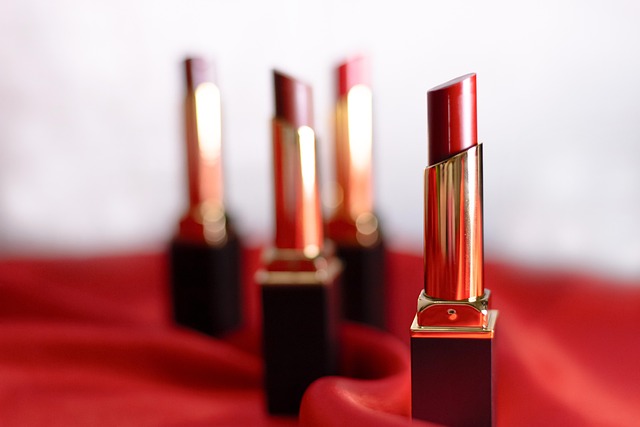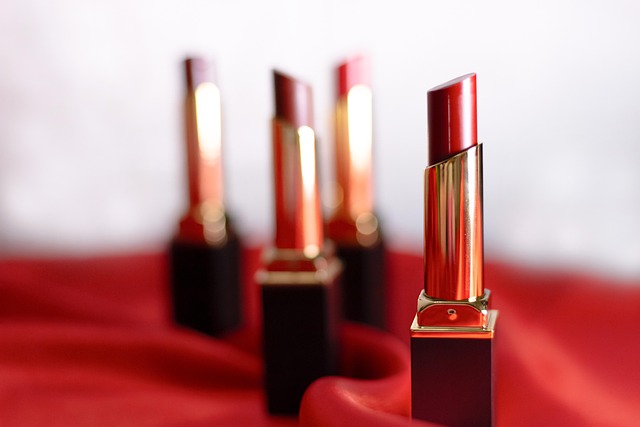Selecting the perfect lipstick involves understanding your skin tone and undertone. Warm tones suit earthy shades like burgundy, while cool tones are flattered by vibrant hues. Neutral skin tones offer versatility, suiting both bold and subtle shades. Testing different shades on your skin ensures a flattering look, with lipstick complementing your unique complexion. Observing wrist veins can help identify undertones: greenish for warm, bluish for cool, neither for neutral. This knowledge guarantees lipstick complements your natural beauty, creating a harmonious, statement-making look.
Unleash your inner beauty guru with our comprehensive guide on mastering the art of applying layers of lipstick! In today’s world, a flawless pout is just a swipe away. This article will transform you from novice to pro, teaching you how to choose the perfect lipstick for your skin tone and create a multi-layered look that lasts all day. From understanding undertones to blending techniques and final touches, we’ve got you covered. Get ready to experiment with different shades and achieve that bold, sophisticated pout everyone will notice!
- Choosing the Right Lipstick for Your Skin Tone
- – Understanding warm, cool, and neutral undertones
- – Selecting lipsticks that complement your skin tone
Choosing the Right Lipstick for Your Skin Tone

Choosing the right lipstick starts with understanding your skin tone. Warm skin tones look best with earthy, rich shades like burgundy, terracotta, and deep plums. Cool skin tones are flattered by vibrant, icy hues like fuchsia, blue-based red, and bright coral. Neutral or olive skin tones have the most versatile options to choose from, suiting both bold and subtle shades.
When selecting a lipstick, consider your skin’s undertone as well. A warm undertone pairs nicely with warmer lipstick shades, while a cool undertone is complemented by cooler tones. Testing different lipsticks on your skin can help you make an informed decision, ensuring the shade enhances your natural glow rather than clashing with it.
– Understanding warm, cool, and neutral undertones

When choosing a lipstick shade, understanding your skin’s undertone is crucial for complementing and enhancing your natural complexion. Skin undertones are often described as warm (with yellow or golden hues), cool (with pink or blue undertones), or neutral (a balance between the two). Warm undertones look vibrant with rich, bold lipsticks that have orange, peachy, or coral undertones, while cool undertones pair best with shades that lean towards rose, cherry, or berry. Neutral undertones allow for more versatility, suiting both warm and cool-toned lipcolors.
Identifying your skin’s undertone is a simple process of observation: look at the veins on your wrist. If they appear greenish, you likely have warm undertones; if they look bluish, you’re probably cool. Neutrals will have veins that seem neither green nor blue. Knowing this helps in selecting lipstick shades that not only suit your skin tone but also create a harmonious and flattering look.
– Selecting lipsticks that complement your skin tone

When selecting lipsticks, choosing shades that harmonize with your skin tone is essential for a flattering and natural look. Start by considering your complexion: warm tones tend to complement earthy, rich, and reddish hues, while cool tones are enhanced by pinks, purples, and blues. Neutral or olive skin tones are versatile, allowing for a wide range of colors.
For the best results, swatch multiple lipsticks on your lips to see how they appear under different lighting conditions. This ensures that the color looks good throughout the day, as lighting can alter perceptions. Experimenting with various shades will help you find the perfect lipstick that enhances your natural beauty and makes a statement at the same time.
Applying layers of lipstick can elevate your look, but it’s all about finding the right balance. By understanding your skin tone and choosing shades that complement it, you can create a stunning, harmonious effect. Whether you opt for a single, bold color or layer different tones for depth, remember that practice makes perfect—so keep experimenting until you find your signature style.
